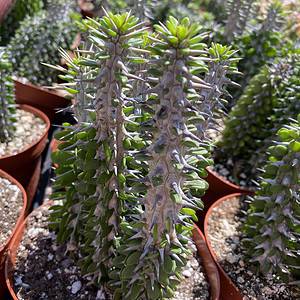No products in the cart.
Table of Contents
Okay, looking at the starfish cacti, it is so pretty. The Stapelia plants are something to admire, especially the carrion flower.
So, if you want a spineless succulent, then give that green thumb a try with the starfish cactus. Still, be warned the smell produced by the flower gives off an unpleasant odor like rotting meat.
But it remains a captivating indoor plant, and the scent does not travel through the home (chuckle) if you were wondering.
Exciting Facts About The Starfish Cactus
You find the Stapelia called by different names from the carrion flower, and starfish plant, and also part of the milkweed family. This outdoor plant belongs to the Apocynaceae subfamily.
These are interesting plants native to South Africa, and you can find more than 90 species closely related to this plant.
When you look at desert succulents that can tolerate drought this plant is similar. The most intriguing part is the star-shaped flowers. But as we mentioned, it smells like rotting meat.
Still, with its good looks (possessing insect-attracting flora), the succulent plant attracts flies that lay eggs on the blooms to spread the pollen from one plant to another.
The blooms are tall with a prominent pattern and texture you do not find in other flowering plants. You can see the flowers grow and form the base part of the shoots.
Okay, we must agree that the smell can vary from one gardener to another. So, if you plan to keep it on the porch or in a warm greenhouse, yet that foul smell will become overwhelming.
The best place is in an open room or grows this rare plant in your garden. Yet, for us, the looks make up for the foul smell.
Starfish Flower Cactus Care
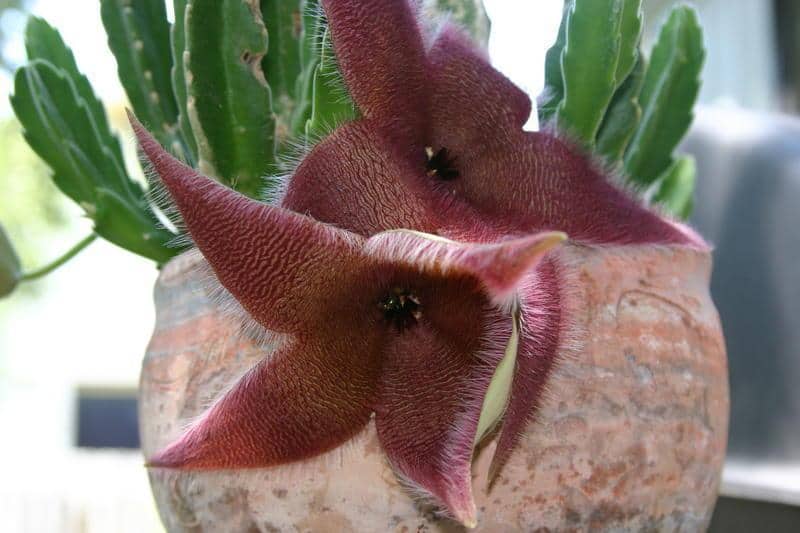
The succulent plant surprisingly is easy to look after. They can grow a bit during spring and summer. But they are carefree indoor plants from winter to spring. So we recommend placing your starfish flowers outdoors in summer and keeping them in a bright spot indoors in winter.
Species: Stapelia
Common Name: Stapelia flowers, carrion flowers, starfish flower
Family: Apocynaceae subfamily
Plant Type: Succulent
Native to: Southern Africa
Maximum Size: 3.94 inches tall
Watering Requirements: Moist with drying out in between watering
Light Requirements: Bright indirect light
Preferred Humidity: High
Preferred Temperature: Warm
Soil or Potting Medium: Airy well-drained soil
Fertilizer: None
Propagation Method: Seed or cuttings
Vulnerability: Overwatering
Toxicity: Non-toxic to pets
Carrion Plants Care Best Potting Mix
These soft-stemmed plants thrive in a well-draining cactus mix, like most succulents. The genus Stapelia thrives in a cactus potting mix with some organic matter.
But remember not too acidic, and it needs to allow the water to run freely from the drainage holes. Remember, the plant comes from tropical regions and also needs no feeding.
So, you can invest in a commercial mix or prepare one yourself. Here is a DIY recipe:
- Five parts regular soil
- Two parts perlite or pumice that helps retain moisture longer
- Coconut coir to keep the pH levels right not to make it too acidic
Ideal Lighting For Your Thickly-Skinned Plant
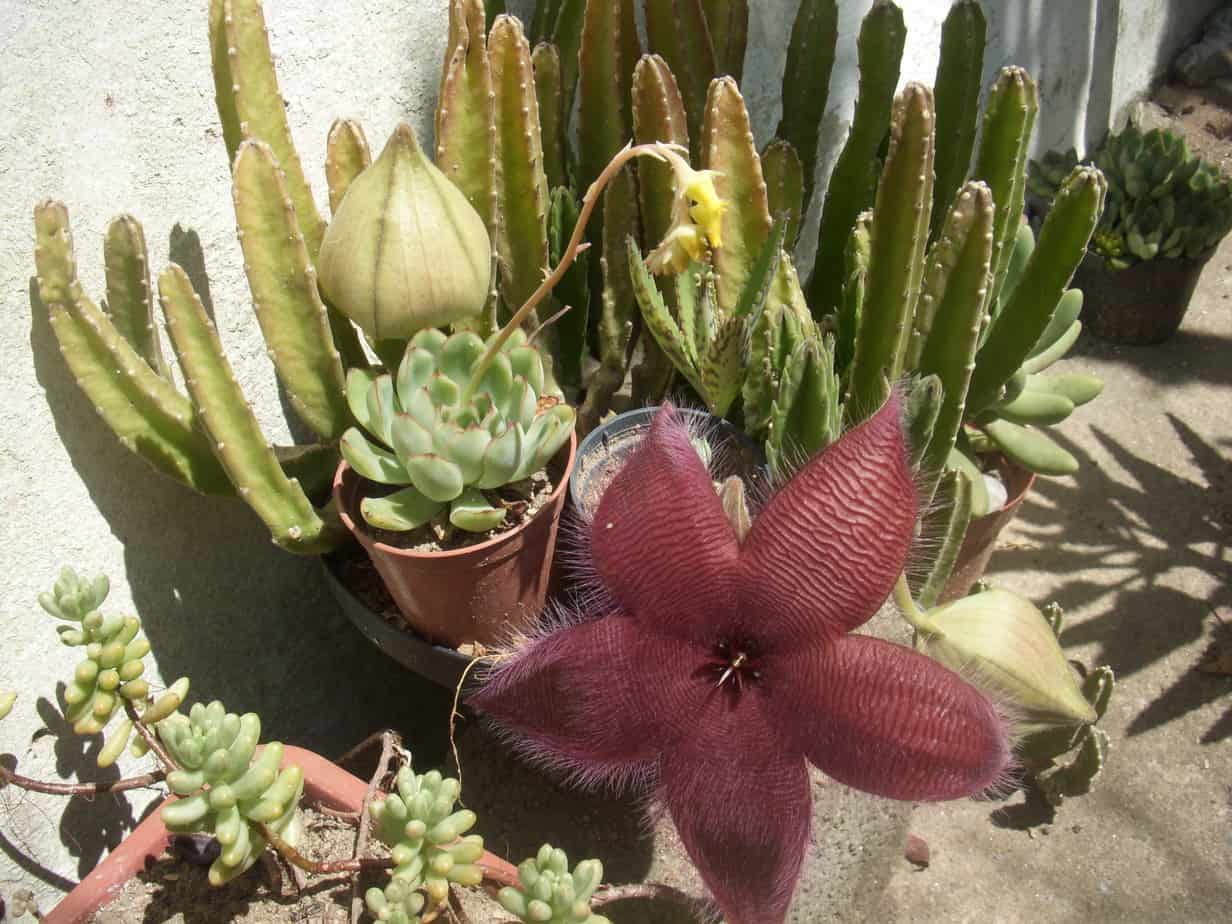
Succulents Stapelia plants, you might think, bask all day in full sun. But, while your starfish flower succulent loves direct sunlight, it grows best in indirect sunlight, allowing some partial sun.
Placing your succulent group plants in insufficient light, on the other hand, blocks chlorophyll production. Eventually, this leads to discolored foliage.
Watering Needs For Starfish Cactus
Yes, we know you want to get your Stapelia cactus as big as possible to show off its striking feature, the flower. But, stop right there and do not go and overwater your Stapelia flower.
Most Stapelia plants store water to survive when temperatures reach a high. Please keep the soil lightly moistened and leave it dry between watering.
The soil should dry out instead of having consistent moisture leading to root rot. Yet, compared to several species in the cacti, it still needs more water.
You can water your Stapelia cactus during summer once every two weeks when spring arrives, and water your indoor plant at intervals once per month.
During winter, space out your watering schedule further. Or you can leave it the whole season. Provide your cacti with water if you leave the ground completely dry and notice the stems shriveling.
Temperature & Humidity
Your Stapelia cactus loves a warm area with humidity. So, growing your plant is pretty easy in a container. The reason is that when it stands outside you can bring it indoors in winter.
In cold months it helps to keep the temperature above 50°F (10°C) and keep them dry for the winter season unless it starts to wilt.
Also, do not place your plant near a heated-up AC; instead, using a heated growing bench or a cover can keep the fragile parts surviving.
Still, placing them grouped with your other plant collection can provide your Stapelia flower with the moisture it needs.
Potting and Pruning Stapelia Flower
Once you notice your starfish plant stems begin growing too wide and tall, it is time to transplant them. Again, the best time to do this is in the growing season of spring.
Invest in a potting medium a bit wider, allowing the stems to grow in any direction. Place a layer of pebbles at the bottom to help improve the drainage.
Now, about pruning, there is no need to prune your succulents except for removing dead stems. You can also remove the flowers to encourage new blossoming when the flowers die.
Propagation of Stapelia Flower
These succulents can propagate by planting seeds or using stem cuttings. Still, remember when sowing seeds, it can take a couple of days for them to sprout.
For stem cuttings, you can use a sterilized sharp knife to remove a part of the mature plant. As with repotting, the best time is early spring or summer when it grows.
Leave your cuttings outside for the night to help the wounds heal. Get a pot ready with a potting mix and check that it has ample drainage.
Moisten the ground, place your seed/cuttings in it, and put it without a covering in light conditions with temperatures ranging between 59 to 64 degrees Fahrenheit (15 to 18 degrees Celsius.)
Growth Zone for The Best Flowers
These flowers are winter hardy in zones nine and above, but we still recommend bringing them indoors during the winter season.
Stapelia Cactus Varieties
Stapelia variegata
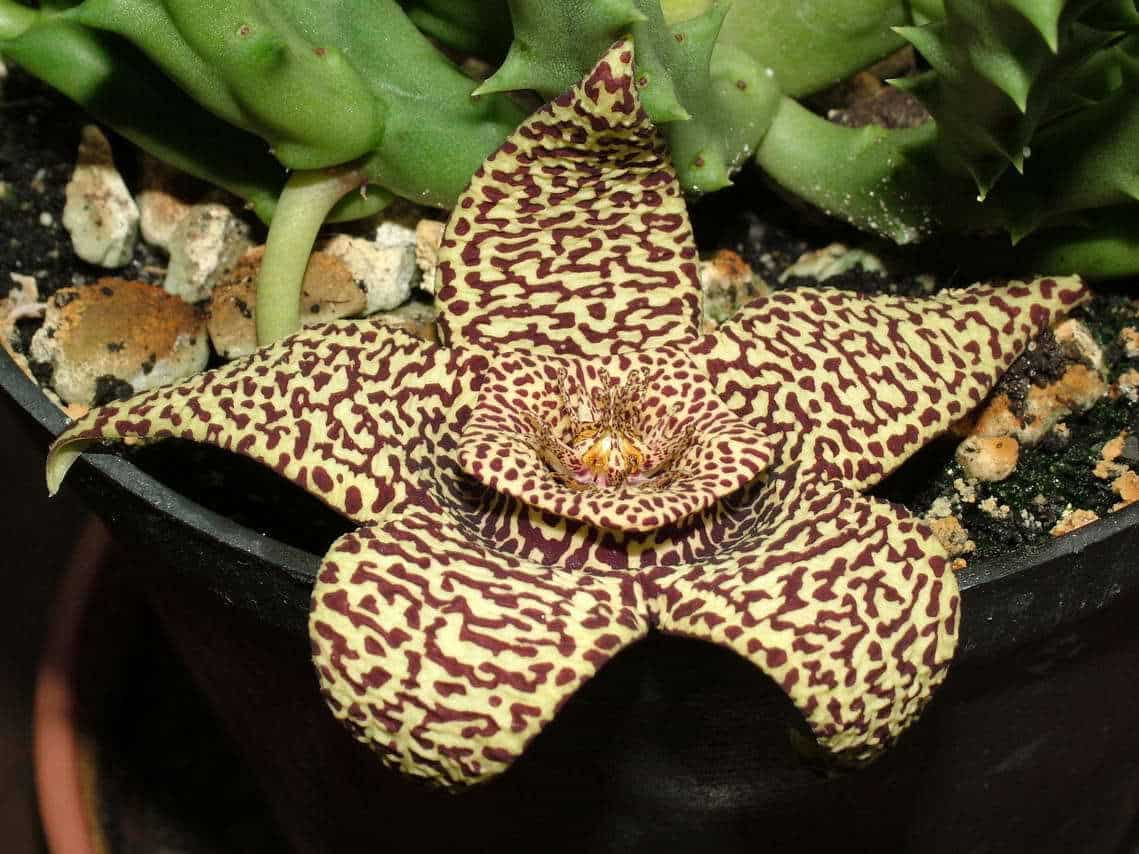
You will find these flowers growing up to six inches high. The yellow blooms are pretty with a purplish yet brown pattern.
Stapelia hirsuta
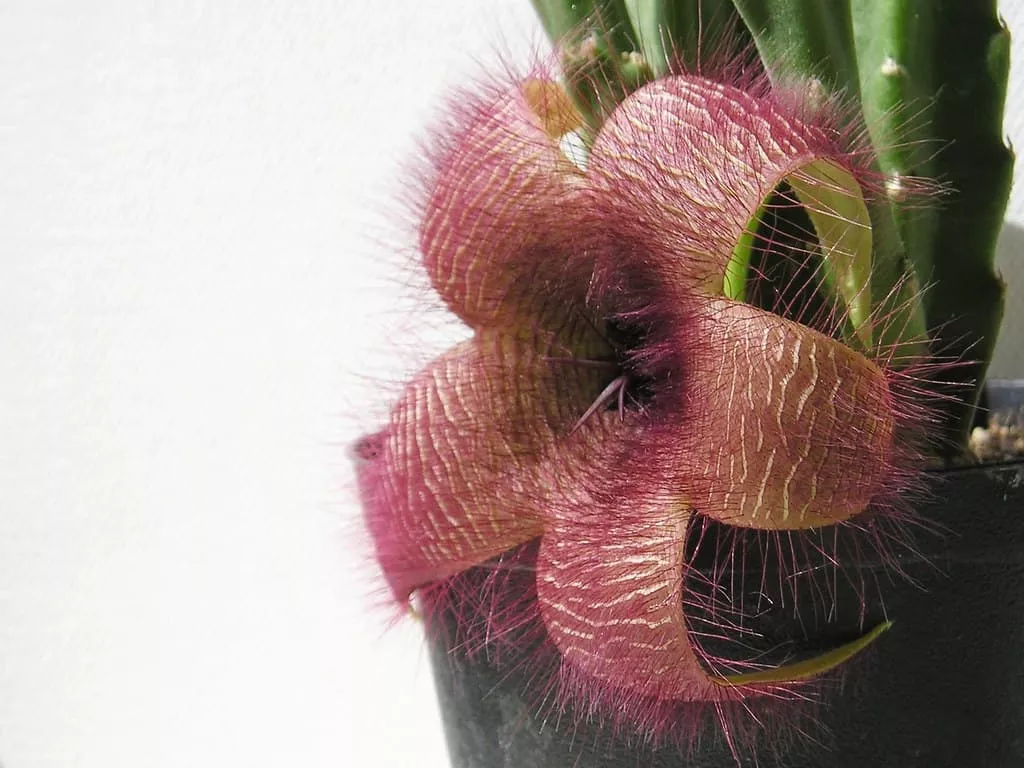
The plant is furry on the stem and slimmer than the Stapelia variegata. It can reach a height of eight inches. Even the purple-brown flowers have hair and look flashy. The petals have different yellow stripes, while the hairs are reddish.
Stapelia Grandiflora
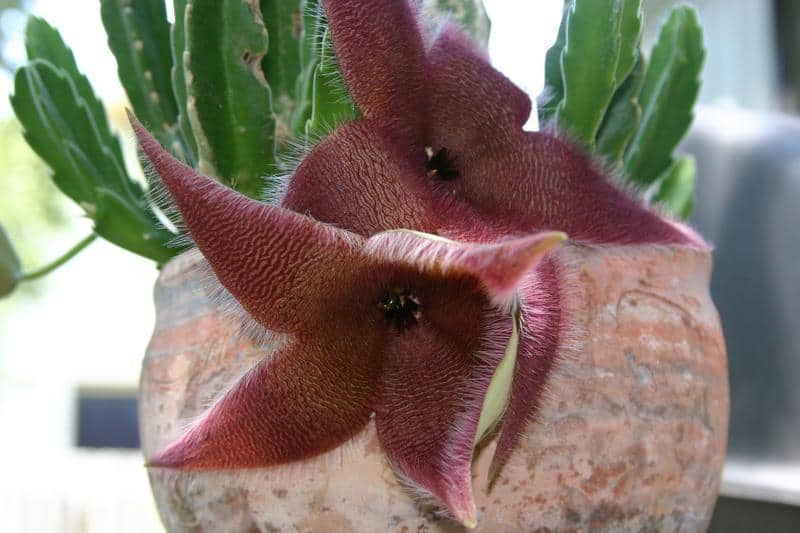
The succulent has a slim yet long stem growing up to a foot long. It is also covered with velvety fur and has large flowers with a deep red shade. The trimmed white edges of the blossoms stand out.
Stapelia gigantea
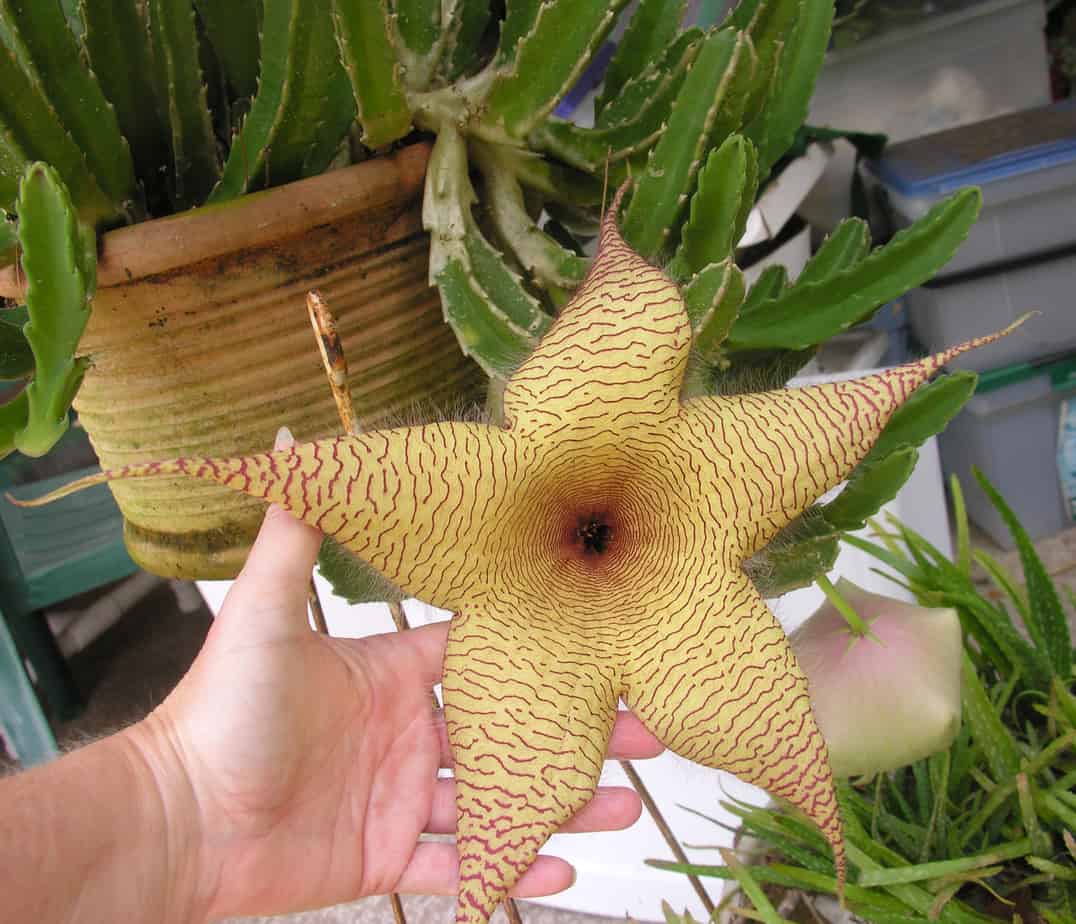
Now, this is a plant with the largest flowers known as the Zulu giant. The plant has a velvety stem and grows up to eight inches long. It has a pale blossom with tints of yellow and thin red stripes.
Stapelia Plant Diseases & Pests
As with other plants, your carrion flower can also get some problems as follow:
- Black stem rot is caused by overwatering your starfish plant. The best is to cut away the rotted areas and transplant them into a new pot.
- Stems become flabby and shriveled resulting from underwatering. Luckily, this is an easy fix by placing the container in a tray of water to soak up as much as it can. Then, allow the excess moisture to drain and water once the soil is parched.
- Yellow stippling on the stems can be from spider mites, and you can use a water cotton ball or isopropyl alcohol to remove them.
- Other pests are mealybugs you can scrape off with a knife blade and treat with neem oil.
Frequently Asked Questions
No, the succulent plant is not toxic to animals or humans.
The best you can do is leave your plant alone and water it when the ground dries out. Neither does it need to be in strong sunlight to bloom. Once the weather warms up, you will notice tiny buds emerging.
These succulents grow fast, and you may find yours blooming after three years if grown from seeds.
While it is a rare plant, you might not find it in your local garden center. But do not stress as Plantly can help you find one here.
Whether you want to buy, sell or simply reach out to other plant enthusiasts, Plantly is the right place to be!
-
$12.00Sold By: Smoot's Farm
In stock
Cactus Bishop’s Cap Hat Astrophytum Myriostigma 3” Pot
Rated 4.89 out of 5 based on 27 customer ratings00Sold By: Smoot's Farm -
$31.99Sold By: Succulent Oasis
In stock
False Ocotillo Cactus
Rated 4.84 out of 5 based on 352 customer ratings00Sold By: Succulent Oasis -
$15.00Sold By: Stripes and Variegations
Only 1 left in stock
Monks Hood
Sold By: Stripes and Variegations -
$10.00Sold By: Stripes and Variegations
Only 1 left in stock
Paper spine cactus or Pinecone Cactus
Sold By: Stripes and Variegations

